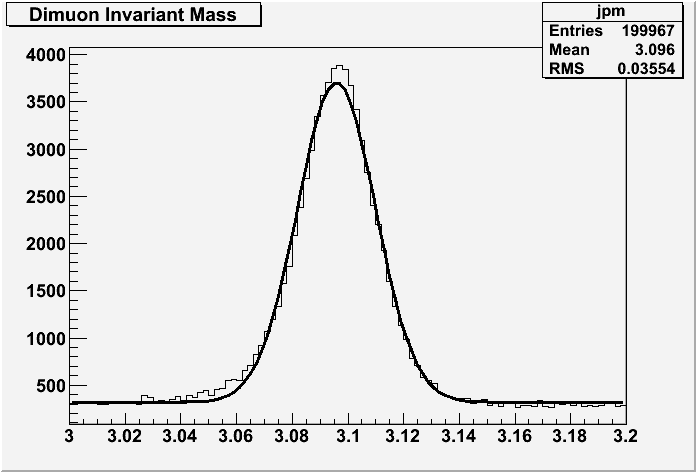Finding the J/ψ
To calculate information about any
mesons formed in the collider, you’ll need to write a
ROOT program to loop over all of the data. You already have the basic
framework of this program. Open it up and take a look by typing:
emacs JPsiMass.C &
This program creates a new ROOT file which
will contain histograms and a tree of new variables. It then begins a
nested loop function. It loops over every event in the data set, and within
each event it loops over muon tracks to find every possible pair of a muon
and an anti-muon. A few cuts are made along the way to single out only
those tracks recorded by the most sensitive parts of the detector, which
will make your end results more precise.
There is an empty space inside the muon
loops for your code. You will need to write a few lines here to calculate the
mass of the J/ψ
candidate. That mass is stored in a leaf of the output tree
and in the mass histogram, using the “fill” command as given in the program.
The loops continue, saving the mass from every possible muon pair, until finally
the program writes the output ROOT file to disk.
Some parameters given in the
jpmm0d_stripped.root file which you may need to calculate J/ψ
mass or other quantities:
-
muon transverse momenta:
MOM_pt[track #]. Since every leaf is really an array, you need to
specify the entry number in brackets. For example, transverse momentum
of the anti-muon would be MOM_pt[trkp].
-
other directional muon momenta:
MOM_px[#], MOM_py[#], MOM_pz[#]
-
impact parameter of the muon track
with respect to the detector centre: TRACK_trk_nonbc_d0[#]
-
phi of the muon track:
TRACK_trk_nonbc_phi[#]
Try writing some code to calculate the
J/ψ
mass. When you’re ready to run the program, save the changes
to JPsiMass.C and execute it by starting root and typing:
.x JPRun.C
Wait until the program finishes running,
then open up your output file:
TFile*
inputFile = new TFile("jpm.root","READ");
View the contents of the file using the
browser. You should see several leaves and your mass histogram. Open up the
histogram and check that it has an obvious peak at the J/ψ
mass. Congratulations, you have found some J/ψs!
One useful feature of ROOT is its
ability to modify histograms with a custom fit. The file bellbkg.C
contains a definition for a Gaussian function with 4 parameters to be fit:

With jpm.root open in root
so that the mass histogram is accessible, load up bellbkg.C:
.L bellbkg.C
Now enter these commands to set up the fit. The first command
creates a fit object and defines the range of values to fit over (3.00 to 3.20
GeV in this case) and the number of parameters to fit (4). The second
gives starting estimates for the four parameters to be fit:
TF1 *func = new TF1("func", gausbkg, 3.00, 3.20, 4);
func->SetParameters(5.0,
3.09, 0.01, 1.0);
Now try to apply the fit to your histogram:
jpm->Fit("func");
You should see a bell curve drawn on the canvas. If you get a flat
line instead, try entering the last line again. The parameters of the fit
are displayed in the ROOT command line.

Once you have your mass histogram, try
adding more code inside the muon loops to fill the other leaves of the tree.
Some things to calculate are:
-
transverse and z momenta of the
J/ψ
-
location of the vertex where the
two muon tracks intersect (i.e. the probable location of the
J/ψ)
-
distance between the
J/ψ vertex
and the location of the beam (the beam location coordinates have already
been retrieved in the code and are stored as primarysvxx and primarysvxy)
